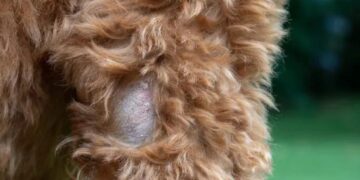Table of Contents
Introduction: Beyond the Scratch – A Systemic Approach to Canine Allergy Management
The persistent sound of a dog scratching, licking, or chewing is a primary concern for countless dedicated owners.
This behavior, known as pruritus, is more than a mere annoyance; it is a significant clinical sign indicating an underlying and often complex medical condition.
While the immediate goal is to stop the itch and provide relief, a truly effective management strategy must look beyond this surface-level symptom.
The itch is not the disease itself but an external signal of a systemic issue: an overactive and misdirected immune system.1
Treating only the symptom often leads to a frustrating cycle of temporary relief followed by recurring flare-ups, a common experience for owners and their veterinary care teams.3
To navigate the complexities of canine allergies, it is helpful to adopt a conceptual framework.
One of the most effective is the “Leaky Bucket” analogy.5
In this model, every dog has a metaphorical bucket representing its individual threshold for an allergic reaction.
Various factors act as “water” filling this bucket.
These inputs include environmental allergens like pollen and dust mites, specific food ingredients, flea saliva, and even internal stressors like poor gut health or concurrent illness.7
Symptoms—the relentless itching, red skin, and secondary infections—only appear when the cumulative total of all these inputs causes the bucket to overflow.
This explains why a dog may seem to react to a minor trigger, when in reality, that trigger was simply the final drop in an already full bucket.
This report is designed to serve as a comprehensive guide for the educated and proactive dog owner.
Its objective is to move beyond temporary fixes and outline a multi-layered, systemic strategy for long-term comfort and health.
The focus will be twofold: first, to identify and reduce the “water” flowing into the bucket through allergen identification and environmental control; and second, to effectively “drain” the bucket by healing the body from within, modulating the immune system, and strengthening the skin’s natural defenses.
This report will provide the necessary knowledge to foster a collaborative partnership with a veterinarian, enabling the development of a personalized and sustainable management plan that addresses the root causes of a dog’s allergic discomfort.
Part I: Understanding the Allergic Dog
Section 1.1: The Immune System’s False Alarm: The Pathophysiology of an Allergic Reaction
An allergy is fundamentally an inappropriate and exaggerated response by the immune system to a substance, known as an allergen, that should be recognized as harmless.1
This process can be understood as the body’s sophisticated defense system “going rogue” and launching an attack against a perceived threat that poses no actual danger.9
The development of an allergic reaction occurs in two distinct phases.
The first is the Sensitization Phase.
Upon initial exposure to an allergen—be it a specific pollen grain or a protein molecule in food—the immune system is “primed.” Specialized cells process the allergen and present it to T-lymphocytes, which in turn signal B-lymphocytes to produce a class of antibodies known as Immunoglobulin E (IgE).
These allergen-specific IgE antibodies then attach themselves to the surface of mast cells, which are immune cells located in the skin, respiratory tract, and gut.
This process effectively “loads the allergy cannons,” preparing them to fire upon the next encounter.10
A dog can be in this sensitized state for months or even years without showing any outward signs of an allergy.
This biological process explains why a dog can seemingly tolerate a particular food or environment for a long time before suddenly developing a reaction; the sensitization was occurring silently, and the threshold for activation had not yet been crossed.
The second phase is the Activation Phase.
When the dog is subsequently exposed to the same allergen, it binds to the IgE antibodies on the mast cells.
This binding triggers a rapid process called degranulation, an “explosion” that releases a cascade of potent inflammatory mediators into the surrounding tissue.1
The most well-known of these mediators is histamine, which is responsible for the immediate signs of an allergic reaction: vasodilation (leading to redness), increased vascular permeability (leading to swelling or hives), and stimulation of nerve endings (leading to intense itching).2
However, histamine is only part of the story.
Mast cells also release other powerful chemicals, such as leukotrienes, prostaglandins, and cytokines.
These mediators perpetuate the inflammatory cycle, attracting more immune cells to the area and contributing to the chronic skin changes seen in allergic dogs.12
This complex chemical cascade is why the itch can persist long after the initial trigger is gone.
This intense pruritus initiates a self-perpetuating itch-scratch cycle.
Itchy skin is the most common symptom of allergies in dogs.14
The dog’s natural response—scratching, licking, and chewing—provides temporary relief but causes physical trauma to the skin, damaging its protective barrier.
This compromised barrier becomes an ideal environment for the overgrowth of bacteria (Staphylococcus) and yeast (Malassezia) that normally live on the skin in small numbers.
This overgrowth leads to secondary infections (pyoderma and yeast dermatitis), which cause further inflammation and itching, driving the dog to scratch even more and creating a vicious cycle that is difficult to break without intervention.14
Section 1.2: Identifying the Adversary: A Typology of Canine Allergens
While the underlying immune mechanism is similar, canine allergies are typically categorized by the nature of the triggering allergen.
Understanding these categories is crucial for diagnosis and management, as the patterns of symptoms often provide important clues.
Atopic Dermatitis (Environmental Allergies)
Atopic dermatitis is the most common type of allergy in dogs, resulting from an allergic reaction to allergens that are inhaled or come into direct contact with the skin.15
- Common Culprits: The primary environmental triggers include pollens from grasses, trees, and weeds; molds and yeasts; and microscopic dust mites and storage mites that live in bedding, carpets, and dry food.16
- Symptom Pattern: The condition often begins seasonally, with flare-ups in the spring and fall corresponding to high pollen counts.18 Over time, as the dog becomes sensitized to more allergens (like indoor dust mites), the itching can become a year-round problem.19 The classic distribution of pruritus involves the paws (leading to constant licking and saliva staining), ears (resulting in chronic or recurrent infections), face (rubbing), axillae (underarms), and ventral abdomen (belly).15
Cutaneous Adverse Food Reactions (CAFR)
CAFR refers to an immune-mediated reaction to a component in the diet, typically a protein or, less commonly, a carbohydrate.20
True food allergies are less prevalent than environmental allergies, affecting a smaller percentage of the allergic dog population.19
- Common Culprits: The most frequent offenders are proteins to which the dog has had long-term exposure. These commonly include beef, chicken, dairy, eggs, wheat, and soy.17 The popular focus on “grain-free” diets can be misleading, as allergies to animal proteins are far more common than allergies to grains.19
- Symptom Pattern: The hallmark of a food allergy is non-seasonal, year-round itching that does not respond to seasonal changes.19 The skin symptoms can closely mimic those of atopic dermatitis, with itchy paws and ears being common. However, a key diagnostic clue is the presence of concurrent gastrointestinal signs, such as chronic gas, loose stools, diarrhea, or occasional vomiting.15
Flea Allergy Dermatitis (FAD)
FAD is an intensely pruritic condition caused by a hypersensitivity reaction to proteins present in flea saliva.1
For a sensitized dog, the bite of a single flea can be enough to trigger a severe, body-wide reaction.17
- Symptom Pattern: The clinical presentation of FAD is often classic and highly suggestive of the cause. The itching is most severe at the base of the tail, along the lower back, and down the hind legs, an area often referred to as the “pants” region. This distribution leads to characteristic hair loss, redness, scabs, and skin thickening in these areas.15
A critical and often underappreciated aspect of canine allergies is that these categories are not mutually exclusive.
Many allergic dogs suffer from a combination of conditions.
For instance, a dog with a baseline environmental allergy to pollen may also have a coexisting food allergy to chicken and be highly sensitive to flea bites.
This overlap helps explain why single-pronged treatment approaches often fail to provide complete relief.
An owner might diligently pursue a strict food trial and see some improvement, only to become frustrated when the dog’s itching returns with the spring pollen season.
This reinforces the utility of the “Leaky Bucket” analogy: fleas, food, and pollen are all different streams of water filling the same bucket.
To lower the water level below the point of overflow (symptoms), it is often necessary to address all contributing streams simultaneously rather than searching for a single “magic bullet” cause.
Section 1.3: The Diagnostic Pathway: From Clinical Signs to Confirmed Cause
A definitive diagnosis is the cornerstone of an effective allergy management plan.
Given the significant overlap in symptoms and the existence of other skin conditions that can mimic allergies, a systematic approach guided by a veterinarian is essential.15
The foundational step is a thorough physical examination and history.
A veterinarian must first rule out other common causes of itching, such as parasitic infections like sarcoptic mange (scabies) or Demodex mites, and fungal infections like dermatophytosis (ringworm).23
The diagnostic process then typically proceeds as follows:
- Implement Strict Flea Control: Before any advanced testing, the first diagnostic step is to ensure the dog is on a veterinarian-recommended, high-quality flea and tick preventative.14 This is crucial because FAD is extremely common and can be a major contributing factor even in dogs with other allergies. If complete resolution of symptoms occurs with strict flea control, FAD is confirmed as the primary issue.
- Diagnose Atopic Dermatitis: If itching persists despite excellent flea control, environmental allergies are suspected. The specific triggers can be identified through allergy testing.
- Intradermal Skin Testing (IDT): This is considered the “gold standard” by veterinary dermatologists.24 The procedure involves sedating the dog, shaving a patch of skin, and injecting tiny amounts of various purified allergens (pollens, molds, mites). The site is then monitored for localized reactions (small hives), indicating which substances the dog is allergic to.
- Serology (Blood Testing): This method measures the level of allergen-specific IgE antibodies in a blood sample.24 It is less invasive than IDT but is generally considered less reliable, with a higher potential for false-positive results.9 The primary purpose of either IDT or serology is not simply to diagnose atopy, but to identify the specific allergens required to formulate a customized allergen-specific immunotherapy (ASIT) treatment.24
- Diagnose Cutaneous Adverse Food Reactions (CAFR): The only reliable method—the definitive gold standard—for diagnosing a food allergy is the elimination diet trial.20 Blood, saliva, and skin tests for food allergies are notoriously inaccurate and are not recommended by veterinary dermatologists for this purpose.19
- The Protocol: The trial involves feeding the dog a diet containing only ingredients it has never been exposed to before. This is typically a novel protein diet (e.g., rabbit, kangaroo, venison) or a hydrolyzed protein diet, where the protein molecules have been broken down into components too small for the immune system to recognize as allergens.20
- Duration and Adherence: This special diet must be fed exclusively for a minimum of 8 to 12 weeks.21 Strict adherence is the most critical factor for success. During this period, the dog must consume absolutely nothing else—no other treats, no flavored medications or supplements, no dental chews, no table scraps, and no access to other pets’ food.20 This is the most common point of failure in the diagnostic process.
- The Re-challenge: If the dog’s clinical signs resolve or significantly improve during the trial, a food allergy is strongly suspected. To confirm the diagnosis and identify the specific trigger, the original food and ingredients are reintroduced one at a time, for a period of up to two weeks each. A relapse of symptoms upon the reintroduction of an ingredient, such as chicken, confirms it as a causative allergen.17
Part II: The Spectrum of Therapeutic Interventions
Once a diagnosis is established, a multi-modal treatment plan can be developed.
Conventional therapies are primarily aimed at providing relief by managing the symptoms of the allergic reaction.
These interventions can be thought of as “turning down the volume on the immune system’s fire alarm” rather than extinguishing the underlying fire.
They are often essential for breaking the itch-scratch cycle and providing immediate comfort to the suffering dog.
Section 2.1: The Conventional Arsenal: Pharmaceutical Management of Allergic Itch
Several classes of medications are used to control pruritus and inflammation.
Each has a different mechanism of action, efficacy profile, and set of potential side effects.
- Corticosteroids (e.g., Prednisone, Triamcinolone): These are potent, broad-spectrum anti-inflammatory drugs that work quickly to suppress the immune response and reduce itching.25 They are inexpensive and highly effective for managing acute, severe flare-ups.25 However, their use is associated with significant and predictable side effects, including increased thirst and urination (polyuria/polydipsia), increased hunger (polyphagia), panting, and potential for behavioral changes.28 Long-term use carries substantial risks, such as suppression of the immune system, thinning of the skin, liver changes, and an increased risk of infections, making them unsuitable for chronic, lifelong management.25 A common source of owner frustration is the rapid return of symptoms as soon as the medication is discontinued, highlighting that steroids only mask the problem temporarily.28
- Antihistamines (e.g., Diphenhydramine, Cetirizine): These drugs work by blocking histamine receptors. While a mainstay in human allergy treatment, their efficacy in dogs is limited. Studies and clinical experience show they provide, at best, mild relief in only 30-40% of allergic dogs and are generally ineffective for moderate to severe pruritus.24 The most common side effect is sedation.29
- Calcineurin Inhibitors (e.g., Cyclosporine/Atopica): Cyclosporine is an immunosuppressive drug that is more targeted than steroids, primarily inhibiting the activation of T-cells. It is an effective non-steroidal option for the long-term management of atopic dermatitis in approximately 80% of dogs.25 Its main drawbacks are cost, a slow onset of action (it can take 4-6 weeks to see the full effect), and a high incidence of gastrointestinal side effects, particularly vomiting and diarrhea, upon initiation of therapy.25
- Janus Kinase (JAK) Inhibitors (e.g., Oclacitinib/Apoquel): Apoquel is a targeted therapy that works by inhibiting the Janus kinase 1 (JAK1) enzyme. This enzyme is a key component of the signaling pathway that transmits the sensation of itch and triggers inflammation in response to specific cytokines.31 It is a very fast-acting oral tablet, with relief often starting within four hours, making it highly effective for both acute flares and long-term maintenance.31 While it is a powerful tool for stopping the
symptom of itch, it does not address the underlying allergic reaction. As an immunomodulating drug, potential side effects can include gastrointestinal upset and a theoretical increased risk for developing infections.29 It is approved for use in dogs 12 months of age and older.31 - Monoclonal Antibody Therapy (e.g., Lokivetmab/Cytopoint): Cytopoint represents a form of biologic therapy rather than a traditional drug. It is an injectable canine-specific monoclonal antibody that is designed to target and neutralize a single molecule: Interleukin-31 (IL-31). IL-31 is a key cytokine responsible for sending the itch signal from the skin to the brain in atopic dogs.30 By intercepting this signal, Cytopoint effectively stops the itch. It is highly targeted, having minimal impact on the broader immune system, and is considered very safe.29 A single injection provides relief for 4 to 8 weeks, which is highly convenient for owners.30 The primary disadvantages are its cost, especially for larger dogs, and the requirement for a veterinary visit for each administration.34 Like Apoquel, it is a symptomatic treatment that stops the itch but does not alter the underlying allergy.
| Table 1: Comparison of Systemic Anti-Pruritic Medications | |||||
| Drug Class / Name | Mechanism of Action | Onset of Relief | Administration | Key Benefits | Common Side Effects/Considerations |
| Corticosteroid / Prednisone | Broad-spectrum anti-inflammatory and immunosuppressant | Hours | Oral tablet | Fast-acting, inexpensive for short-term use | Increased thirst/urination, hunger, panting; significant long-term health risks 28 |
| JAK Inhibitor / Apoquel (Oclacitinib) | Targets the JAK1 signaling pathway to block itch and inflammation cytokines | Hours | Oral tablet | Very fast-acting for acute and chronic itch; convenient oral dosing | Potential for GI upset, increased risk of infections; symptomatic relief only 29 |
| Monoclonal Antibody / Cytopoint (Lokivetmab) | Neutralizes Interleukin-31, a key itch-signaling cytokine | Days | Subcutaneous injection | Long-lasting (4-8 weeks), highly targeted, very safe profile | Cost, requires veterinary visits for injection; symptomatic relief only 30 |
| Calcineurin Inhibitor / Atopica (Cyclosporine) | Suppresses T-cell activation, reducing the inflammatory response | Weeks | Oral capsule/liquid | Effective non-steroidal option for long-term management | Slow onset of action (4-6 weeks), common GI upset, cost 25 |
Section 2.2: Fortifying the First Line of Defense: Topical and External Care
Topical therapy is a critical component of a comprehensive allergy management plan.
These treatments work directly on the skin to provide immediate relief, remove allergens, and treat the secondary infections that perpetuate the itch-scratch cycle.
Frequent bathing, often as much as once a week, is highly beneficial.
Bathing serves several purposes: it physically washes away surface allergens like pollen and dust, it helps to rehydrate the skin, and it provides a vehicle for delivering medicated ingredients.1
The choice of shampoo is important.
Medicated shampoos often contain active ingredients to address specific issues:
- Antimicrobials: Ingredients like chlorhexidine are effective against secondary bacterial infections, while agents like ketoconazole or miconazole target secondary yeast infections.14
- Soothing Agents: Colloidal oatmeal, aloe vera, and certain essential oils (e.g., lavender) can have calming and anti-inflammatory properties that provide temporary itch relief.25
- Topical Steroids: Shampoos, sprays, and creams containing hydrocortisone can deliver potent anti-inflammatory effects directly to the skin. These are useful for localized “hot spots” but must be used judiciously, as overuse can lead to thinning of the skin.25
In between baths, leave-on products like medicated mousses, wipes, and sprays are invaluable for managing problem areas such as paws, skin folds, and the abdomen.14
For dry, cracked, or irritated skin, especially on paw pads or the nose, soothing balms and salves containing natural ingredients like shea butter, coconut oil, or beeswax can help moisturize the skin and support the repair of the damaged barrier.38
Section 2.3: Retraining the Immune System: Allergen-Specific Immunotherapy (ASIT)
Allergen-specific immunotherapy is the only treatment modality that aims to alter the fundamental course of the allergic disease rather than simply suppressing its symptoms.24
Often referred to as “allergy shots” or, more recently, sublingual “allergy drops,” ASIT is a long-term strategy for managing atopic dermatitis.
The treatment is based on the results of intradermal or serological allergy testing.
A custom “vaccine” is formulated containing small, purified amounts of the specific allergens to which the dog has been shown to react.24
By administering these allergens in gradually increasing doses over time, the goal is to desensitize the immune system, inducing a state of tolerance where it no longer overreacts to those substances.24
ASIT requires a significant commitment from the owner.
It can take from six to twelve months to determine if the therapy is effective, and treatment is typically continued for the life of the P.T.24
The success rate is estimated to be between 60% and 80%, with “success” defined as a significant reduction in clinical signs and a decreased need for other anti-itch medications.24
It is not a quick fix, but for responsive dogs, it offers the best chance for long-term, non-pharmaceutical control of their environmental allergies.40
Part III: An Integrative and Holistic Framework for Healing
While conventional therapies are invaluable for managing acute symptoms, a holistic and integrative approach seeks to address the root causes of immune dysregulation.
This philosophy posits that allergies are not merely a “skin problem” but a manifestation of a “whole body” imbalance.32
The goal shifts from symptom suppression to systemic healing, aiming to restore the body’s natural equilibrium and reduce its tendency to overreact.3
Section 3.1: The Root Cause Philosophy: Tending the Garden of Health
To conceptualize this shift in perspective, the “Gardening Analogy” provides a powerful framework.42
In this metaphor, the dog’s skin and coat represent the visible plant.
An itchy, inflamed, and infected skin is akin to a wilting, pest-ridden plant.
The dog’s internal environment—particularly the gut and its microbial ecosystem—is the soil from which this plant grows.
The owner, working with their veterinarian, acts as the gardener.
The core lesson of this analogy is that one cannot restore a sick plant to vibrant health by simply spraying its leaves with a chemical to mask the wilting (symptomatic medication) or by physically picking off pests (treating secondary infections).
While these actions may be necessary for short-term control, true, lasting health can only be achieved by tending to the soil.
This involves enriching the soil with proper nutrients (an anti-inflammatory diet and supplements), removing toxins and weeds (environmental control and detoxification), and ensuring the right conditions for growth (stress reduction and immune support).42
This approach fundamentally reorients the management strategy toward building a foundation of health from the inside O.T.
Section 3.2: The Gut-Skin Axis: The Epicenter of Immune Health
The “soil” in the gardening analogy corresponds directly to the dog’s gastrointestinal tract.
Modern veterinary science has established the existence of the “gut-skin axis,” a complex, bidirectional communication network between the gut microbiome and the health of the skin.45
A staggering 70% to 90% of the body’s immune cells are located in the gut, in a system known as the gut-associated lymphoid tissue (GALT).47
This makes the gut the command center for the entire immune system.
The gut is home to trillions of microorganisms—the microbiome—that play a critical role in training and regulating the immune system.47
A healthy, diverse microbiome promotes immune tolerance, teaching the GALT to differentiate between genuine threats and harmless substances like food proteins and pollen.48
When this delicate ecosystem is disrupted—a condition known as dysbiosis—the consequences can be systemic.
Factors like a highly processed, high-carbohydrate diet, stress, antibiotics, and even steroid use can damage the microbiome.50
This imbalance can lead to increased intestinal permeability, or
“leaky gut.” In this state, the normally tight junctions between intestinal cells loosen, allowing undigested food particles, bacteria, and toxins to “leak” from the gut into the bloodstream.47
The immune system identifies these substances as foreign invaders and mounts a massive inflammatory response.
This chronic, low-grade systemic inflammation is then expressed externally in target organs, with the skin being one of the most common.45
Therefore, from a holistic perspective, healing the skin is impossible without first healing the gut.
This understanding reveals why a purely conventional approach can be frustrating.
A drug like Apoquel or Cytopoint can effectively block the itch signal, making the dog more comfortable, but it does nothing to address the underlying gut dysbiosis and systemic inflammation that are fueling the allergic response.
This is analogous to silencing a smoke detector while the fire continues to smolder within the walls.
The most robust and sustainable management plans often integrate both approaches: using conventional medications for short-term relief to break the itch-scratch cycle and improve quality of life, while simultaneously implementing holistic strategies to heal the gut and address the root cause of the immune over-reactivity.
Section 3.3: Foundational Healing Through Nutrition
Diet is the single most powerful tool for influencing the gut microbiome and reducing systemic inflammation.
The primary goal of a nutritional strategy for an allergic dog is to provide a diet that is minimally processed, low in pro-inflammatory ingredients, and free of the specific components that trigger an immune response.4
- Strategic Diet Trials: As discussed in the diagnostics section, identifying and eliminating specific food allergens is paramount. This is achieved through the strict implementation of a Limited Ingredient Diet (LID), a Novel Protein Diet, or a Hydrolyzed Protein Diet.23 While hydrolyzed diets are effective for diagnosis, their highly processed nature may make them less ideal for long-term gut health compared to a whole-food, limited-ingredient approach.53
- The Raw Food Diet: Many owners and holistic veterinarians report significant or complete resolution of allergy symptoms after transitioning a dog to a species-appropriate raw food diet.54 The rationale behind this approach is multifaceted. Raw diets are inherently free of the high levels of carbohydrates, starches, artificial preservatives, and other additives found in many processed kibbles, which can contribute to gut inflammation and dysbiosis.55 Proponents argue that the proteins in raw food are in their natural, highly digestible state, and that dogs are often reacting to the denatured proteins and other components of processed food, rather than the meat source itself.57 However, this approach is not without considerations. Raw diets can still contain common allergens like chicken or beef, and there are valid concerns regarding the risk of bacterial contamination (e.g., Salmonella, E. coli) and the challenge of ensuring the diet is nutritionally complete and balanced over the long term.58 A transition to a raw diet should be undertaken with careful research and veterinary guidance.
Section 3.4: Targeted Nutritional Supplementation: Modulating the Allergic Response
In addition to a foundational diet, specific nutritional supplements can play a powerful role in modulating the allergic response, strengthening the skin barrier, and restoring gut health.
- Omega-3 Fatty Acids: These are arguably the most important supplement for allergic dogs. Their primary function is to reduce inflammation and support the integrity of the skin barrier.60 The mechanism is elegant: Omega-3 fatty acids (specifically eicosapentaenoic acid, EPA, and docosahexaenoic acid, DHA) directly compete with the pro-inflammatory omega-6 fatty acid, arachidonic acid, for the same metabolic enzymes. This competition shifts the body’s production of eicosanoids (signaling molecules) away from highly inflammatory products like prostaglandin
E2 (PGE2) and leukotriene B4 (LTB4) and towards less inflammatory or actively anti-inflammatory ones like PGE3 and LTB5.12 Furthermore, omega-3s are crucial building blocks for ceramides, which are lipid molecules that form the “mortar” between the “bricks” (skin cells) of the epidermal barrier. A stronger barrier reduces transepidermal water loss (TEWL) and prevents allergens from penetrating the skin.12 - Probiotics: The primary function of probiotics is to restore balance to the gut microbiome and modulate the immune system.48 These are live, beneficial microorganisms that, when administered in adequate amounts, colonize the gut.64 They help to strengthen the intestinal lining, improve nutrient absorption, and compete with pathogenic bacteria for resources.49 Critically, they interact directly with the GALT, helping to “train” the immune system to respond more appropriately and reduce its hypersensitivity to harmless allergens. This can lead to an increase in protective antibodies like secretory
IgA and a more balanced immune response overall.65 - Quercetin: This bioflavonoid, found naturally in many fruits and vegetables, is often referred to as “Nature’s Benadryl” for its potent antihistamine effects.4 Its mechanism of action is fundamentally different from and arguably superior to pharmaceutical antihistamines. Instead of just blocking histamine receptors after the fact, quercetin works upstream by stabilizing the membranes of mast cells. This action prevents them from degranulating and releasing their inflammatory contents—including histamine and cytokines—in the first place.10 It effectively stops the allergic cascade at its source and also possesses direct anti-inflammatory and antioxidant properties.69
- Other Supportive Supplements: Other natural compounds can be beneficial. Bovine colostrum contains proline-rich polypeptides (PRP) and antibodies that can help modulate the immune response.60
Digestive enzymes can improve the breakdown and absorption of nutrients, reducing the burden on the gut.60
Turmeric, containing the active compound curcumin, is a well-known natural anti-inflammatory.32
| Table 2: Key Dietary Supplements for Canine Allergies | |||
| Supplement | Primary Function | Mechanism of Action | Common Forms/Considerations |
| Omega-3 Fatty Acids (EPA/DHA) | Anti-inflammatory, Skin Barrier Support | Shifts eicosanoid production to less inflammatory pathways; serves as a precursor for skin barrier lipids (ceramides).12 | Marine sources like fish oil, krill oil, and green-lipped mussel oil are most effective. Purity and correct dosage based on body weight are critical.71 |
| Probiotics | Gut Health, Immune Modulation | Restores beneficial gut flora, strengthens the gut barrier, and “trains” the gut-associated lymphoid tissue (GALT) to reduce hypersensitivity.49 | Look for multi-strain formulas with a high CFU (colony-forming unit) count. Some products require refrigeration to maintain viability.49 |
| Quercetin | Mast Cell Stabilizer, Natural Antihistamine | Inhibits mast cell degranulation by stabilizing their membranes, preventing the release of histamine and other inflammatory mediators at the source.67 | Often formulated with bromelain (a digestive enzyme from pineapple) to enhance absorption. Best used proactively during allergy season.61 |
Part IV: Creating a Low-Allergen Environment
Managing the dog’s external environment is a critical part of reducing the total allergen load—in other words, minimizing the amount of “water” flowing into the “Leaky Bucket.” For a dog with atopic dermatitis, these practical steps can significantly decrease the frequency and severity of flare-ups.
Section 4.1: Managing the Household Ecosystem
- Air Quality Management: The air inside a home can be a major reservoir for allergens.
- Filtration: Using high-quality air purifiers equipped with High-Efficiency Particulate Air (HEPA) filters is highly recommended. A HEPA filter is capable of capturing up to 99.97% of airborne particles down to 0.3 microns in size, which includes pollen, mold spores, and pet dander.73 For maximum effectiveness, purifiers should be placed in the rooms where the dog spends the most time, such as the living room and bedroom.75 Central heating and air conditioning systems should also be fitted with high-MERV rated filters (11-13) and changed regularly.74
- Vacuuming: Frequent vacuuming (at least once or twice a week) with a vacuum cleaner that also has a HEPA filter is essential. Vacuums without proper filtration can simply aerosolize allergens, making the problem worse.73
- Dust Mite Control: Dust mites are a primary trigger for many atopic dogs.
- Bedding: A dog’s bed is a prime habitat for dust mites. All pet bedding should be washed at least once a week in hot water (130°F or 54°C or hotter) and dried on a hot cycle to effectively kill mites.73 If the dog sleeps on human beds, using zippered, allergen-impermeable covers on mattresses and pillows creates a physical barrier against mites.77
- Humidity: Dust mites thrive in high humidity. Maintaining indoor humidity below 50% through the use of dehumidifiers or air conditioning can make the environment less hospitable for them.73
- Cleaning Protocols and Surface Management:
- Cleaning Products: Use non-toxic, pet-safe, and unscented or “green” cleaning products and laundry detergents. Harsh chemicals and artificial fragrances can act as irritants and contribute to the dog’s overall allergic load.73
- Pollen Removal: To prevent outdoor allergens from being tracked inside, it is beneficial to wipe the dog’s paws, legs, and belly with a damp cloth, a witch hazel spray, or hypoallergenic wipes after every walk, especially during high-pollen seasons.4
- Surfaces: Hard surfaces like hardwood, tile, or laminate flooring are preferable to wall-to-wall carpeting, which acts as a massive reservoir for allergens. If carpeting is unavoidable, low-pile options are better and should be steam-cleaned with caution, as residual moisture can promote mold growth.76
Conclusion: Synthesizing a Personalized, Long-Term Management Protocol
The management of allergic itch in dogs is not a search for a single cure but the implementation of a comprehensive, multi-modal strategy tailored to the individual animal.
The most effective approach moves beyond merely suppressing symptoms and embraces a systemic philosophy aimed at restoring the body’s natural balance.
By integrating the rapid relief offered by conventional medicine with the foundational healing of holistic and environmental management, owners can achieve a sustainable state of comfort and well-being for their canine companions.
The path forward involves a layered strategy that simultaneously addresses the issue from multiple angles:
- Symptomatic Relief: Utilize targeted, modern pharmaceuticals like Apoquel or Cytopoint as needed, especially during acute flare-ups, to break the debilitating itch-scratch cycle and provide immediate comfort. This is a crucial step for the dog’s quality of life while long-term strategies take effect.
- Topical Care: Implement a consistent routine of therapeutic bathing and topical treatments to soothe the skin, remove surface allergens, and manage the secondary infections that complicate the allergic picture.
- Foundational Nutrition: Work with a veterinarian to identify and eliminate food triggers through a strict elimination diet. Transition to a long-term, anti-inflammatory diet that is minimally processed, low in unnecessary carbohydrates, and rich in high-quality nutrients.
- Systemic Healing: Incorporate targeted dietary supplements—specifically Omega-3 fatty acids, probiotics, and quercetin—to actively reduce inflammation, restore gut health, and modulate the immune system’s over-reactivity from the inside out.
- Environmental Control: Diligently manage the dog’s home environment to reduce the overall allergen load, using tools like HEPA filters, frequent cleaning with appropriate products, and dust mite control measures.
This comprehensive approach requires dedication and patience, but it offers the most promising path to reducing the frequency and severity of allergic episodes and minimizing the long-term reliance on immunosuppressive medications.
The ultimate goal is not just to stop the itch, but to cultivate a resilient, thriving dog.
Success hinges on a strong partnership between a knowledgeable, proactive owner and a veterinarian who is open to an integrative approach.
By understanding the “why” behind each intervention and consistently applying this multi-pronged strategy, it is possible to manage the “Leaky Bucket” of allergies and restore peace and comfort to both dog and owner.
Works cited
- Our Guide To Allergic Reactions In Dogs – What To Do – Animal Emergency Service, accessed August 17, 2025, https://animalemergencyservice.com.au/blog/our-guide-to-allergic-reactions-in-dogs/
- Dog Allergies: What Pet Owners Need To Know, accessed August 17, 2025, https://northeasternvetcare.com/dog-allergies-what-pet-owners-need-to-know/
- Unravelling the myth of allergies in dogs | Dr. Peter Dobias, accessed August 17, 2025, https://peterdobias.com/blogs/blog/11808633-unravelling-the-myth-of-allergies-in-dogs
- A Holistic Approach to Your Dog’s Allergies – Thriving Canine, accessed August 17, 2025, https://www.thrivingcanine.com/blog/holistic_approach_dog_allergies/
- The Bucket Analogy: Why Your Problems Come & Go – LSM Clinic, accessed August 17, 2025, https://lsmclinic.co.uk/news-articles/bucket-analogy-problems-come-go/
- Spoon Theory, Thresholds, And Buckets: Ways To Explain Migraine – CareTuner, accessed August 17, 2025, https://www.caretuner.com/knowledge/spoon-theory-migraine/
- The Water Bucket Analogy on Pain – Invigorate Health and Performance, accessed August 17, 2025, https://invigoratehealth.com.au/the-water-bucket-analogy-on-pain/
- The Bucket Analogy: How we can understand and prevent injuries – Pittwater Chiro, accessed August 17, 2025, https://pittwaterchiro.com/bucket-analogy/
- How your dogs immune system can go wrong – Allergies | Kristina Johansen, accessed August 17, 2025, https://www.kristinajohansen.com/dog-nutritionist/dog-immune-system-allergies/
- Most Effective Quercetin Supplement for Dogs – Beyond Allergy Relief – Bonza, accessed August 17, 2025, https://www.bonza.dog/2025/05/quercetin-supplement-for-dogs-more-than-just-allergy-control/
- Mast cell stabilizers: from pathogenic roles to targeting therapies – Frontiers, accessed August 17, 2025, https://www.frontiersin.org/journals/immunology/articles/10.3389/fimmu.2024.1418897/full
- EFFECT OF OMEGA-3 FATTY ACID SUPPLEMENTATION IN THE MANAGEMENT OF CANINE ATOPIC DERMATITIS, accessed August 17, 2025, https://sevenpublicacoes.com.br/ISJM/article/download/6343/12803/28566
- (PDF) The ACVD Task Force on Canine Atopic Dermatitis (XXIII): are essential fatty acids effective? – ResearchGate, accessed August 17, 2025, https://www.researchgate.net/publication/11795087_The_ACVD_Task_Force_on_Canine_Atopic_Dermatitis_XXIII_are_essential_fatty_acids_effective
- 6 Signs Your Dog Is Having an Allergic Reaction – PetMD, accessed August 17, 2025, https://www.petmd.com/dog/general-health/dog-allergic-reaction
- Dog Skin Allergies – Causes, Symptoms & Treatments – Cedar Mill Veterinary Hospital, accessed August 17, 2025, https://www.cedarmillvet.com/site/blog/2024/02/15/skin-allergy-in-dogs
- The Difference Between Food Allergies and Environmental Allergies in Dogs | Small Door Veterinary, accessed August 17, 2025, https://www.smalldoorvet.com/learning-center/wellness/food-seasonal-allergies-dogs/
- Can Itchy Skin Be a Symptom of Allergic Reactions in Dogs?, accessed August 17, 2025, https://www.bpah.net/blog/can-itchy-skin-be-a-symptom-of-allergic-reactions-in-dogs
- Dog Seasonal Allergies: Symptoms and Treatment – PetMD, accessed August 17, 2025, https://www.petmd.com/dog/conditions/skin/seasonal-allergies-dogs
- Food Allergens | Pet Dermatology Clinic, accessed August 17, 2025, https://www.petdermatologyclinic.com/food-allergens
- Food Allergies in Dogs: Does My Dog Have Food Allergies? – MedVet, accessed August 17, 2025, https://www.medvet.com/food-allergy-dog/
- Allergies in Dogs – Dog Owners – Merck Veterinary Manual, accessed August 17, 2025, https://www.merckvetmanual.com/dog-owners/skin-disorders-of-dogs/allergies-in-dogs
- Dog Skin Allergies – Causes, Symptoms & Treatments – American Pet Hospital, accessed August 17, 2025, https://www.modestovethospital.com/site/blog/2021/12/01/skin-allergy-in-dogs
- Pet Allergies | RainTree Veterinary Hospital, accessed August 17, 2025, https://www.raintreevet.ca/blog/pet-allergies/
- Pet Health Tips: Allergies – Purdue University College of Veterinary Medicine, accessed August 17, 2025, https://vet.purdue.edu/hospital/small-animal/primary-care/tips/allergy-tips.php
- Treatment Options for Allergies in Pets – Poland Veterinary Centre, accessed August 17, 2025, https://www.polandvet.com/sites/site-1402/documents/Treatment-Options-for-Allergies-in-Pets.pdf
- Allergies in Dogs: Signs, Symptoms, Treatments – American Kennel Club, accessed August 17, 2025, https://www.akc.org/expert-advice/health/dog-allergies-symptoms-treatment/
- A Veterinary Guide to Treating Itchy Skin in Pets – Food Allergies, accessed August 17, 2025, https://www.amazingsmallanimalpractice.com/services/blog/veterinary-guide-treating-itchy-skin-pets-food-allergies-0
- Prednisone And Allergy Treatment For Dogs And Cats – Leo’s Pet Care, accessed August 17, 2025, https://leospetcare.com/blog/prednisone-and-allergy-treatment-dogs-and-cats
- Clinical Guidelines for the Use of Antipruritic Drugs in the Control of the Most Frequent Pruritic Skin Diseases in Dogs, accessed August 17, 2025, https://pmc.ncbi.nlm.nih.gov/articles/PMC9030482/
- Ditch the Itch: Treatment | Ottawa Animal Hospital East in Holland, MI, accessed August 17, 2025, https://ottawaanimalhospital.com/blog/treating-the-itch/
- Apoquel Is the Trusted #1 Oral Treatment for Canine Allergic Itch Relief 1 – Zoetis, accessed August 17, 2025, https://www.zoetisus.com/products/dogs/trust-apoquel/
- Holistic Treatments for Dogs with Allergies: Types and When To Use | PetMD, accessed August 17, 2025, https://www.petmd.com/dog/general-health/holistic-treatments-for-dogs-with-allergies
- Dog Allergy Treatment in Myrtle Beach | Coastal Veterinary Care, accessed August 17, 2025, https://coastalveterinarycare.vet/dog-allergy-treatment/
- The Big Allergy Issue | Integrative Pet Wellness Center, accessed August 17, 2025, https://integrativepet.com/blog/the-big-allergy-issue/
- Shampoo Allergies in Dogs – Symptoms, Causes, Diagnosis, Treatment, Recovery, Management, Cost – Wag!, accessed August 17, 2025, https://wagwalking.com/condition/shampoo-allergies
- Itchy Dog Shampoo – Natural Dog Company, accessed August 17, 2025, https://naturaldog.com/products/itchy-dog-shampoo
- Best Dog Skin Care Products: Low Prices (Free Shipping) | Chewy, accessed August 17, 2025, https://www.chewy.com/b/skin-care-1433
- Dog Allergy Shampoo – Etsy, accessed August 17, 2025, https://www.etsy.com/market/dog_allergy_shampoo
- Dog Balm Itchy Skin – Walmart, accessed August 17, 2025, https://www.walmart.com/c/kp/dog-balm-itchy-skin
- Living With Animal Allergies – And Trusting Immunotherapy, accessed August 17, 2025, https://allergyasthmanetwork.org/news/living-with-animal-allergies-and-learning-trust-immunotherapy/
- I Found Out I Had Severe Pet Allergies After I Adopted my Dog. Here’s How I Beat Them., accessed August 17, 2025, https://www.rover.com/blog/true-story-pet-allergies/
- Gardening for Growth: What Planting Teaches Us About Healing – Recovery Cove, accessed August 17, 2025, https://recoverycovepa.com/blog/gardening-for-growth-what-planting-teaches-us-about-healing/
- The Body as Garden—A Metaphor for Medicine? | by Colleen Farrell | Medium, accessed August 17, 2025, https://medium.com/@colleenmfarrell/the-body-as-garden-a-metaphor-for-medicine-8af97a5a5061
- Mark’s story – gardening as a metaphor for life – Thrive, accessed August 17, 2025, https://www.thrive.org.uk/get-gardening/marks-story-gardening-as-a-metaphor-for-life
- Gut–Skin Axis: Unravelling the Connection between the Gut Microbiome and Psoriasis – MDPI, accessed August 17, 2025, https://www.mdpi.com/2227-9059/10/5/1037
- The Gut-Skin Connection in Dogs: How Diet Affects Your Dog’s Coat and Health, accessed August 17, 2025, https://caninectar.com/blogs/news/the-gut-skin-connection-in-dogs-how-diet-affects-your-dogs-coat-and-health
- How Gut Health Impacts Seasonal Allergies And Digestion In Dogs, accessed August 17, 2025, https://seaweedfordogs.com/pages/how-gut-health-impacts-seasonal-allergies-and-digestion-in-dogs
- Dog Gut Health And Allergies: Symptoms And Solutions – The Natural Dog Store, accessed August 17, 2025, https://thenaturaldogstore.com/blogs/health/dog-gut-health-and-allergies
- The power of probiotics | Cornell University College of Veterinary Medicine, accessed August 17, 2025, https://www.vet.cornell.edu/departments-centers-and-institutes/riney-canine-health-center/canine-health-information/power-probiotics
- The Tie Between Your Dog’s Gut Health and Their Itching | Zoetis Petcare, accessed August 17, 2025, https://www.zoetispetcare.com/blog/article/dog-gut-health-itching
- Dog Gut Health And Allergies: The Leaky Gut Epidemic – Dogs Naturally, accessed August 17, 2025, https://www.dogsnaturallymagazine.com/why-your-dogs-allergy-treatment-doesnt-work/
- Holistic Allergy Treatment in Dogs – Conditions Treated, Procedure, Efficacy, Recovery, Cost, Considerations, Prevention – Wag!, accessed August 17, 2025, https://wagwalking.com/treatment/holistic-allergy-treatment
- Homemade Allergy-Friendly Dog Diet: A Success Story | Holistic Vet Blend, accessed August 17, 2025, https://holisticvetblend.com/blogs/news/homemade-allergy-friendly-dog-diet-a-success-story
- WHY RAW FEEDING HELPS REDUCE ALLERGIC REACTIONS, SENSITIVITIES AND THE, accessed August 17, 2025, https://ironwillrawdogfood.com/blogs/news/why-raw-feeding-helps-reduce-allergic-reactions-sensitivities-and-their-impact
- Resolving Digestive Distress & Allergy Ailments With A Raw Food Diet, accessed August 17, 2025, https://www.prodograw.com/case-studies/cocos-story-resolving-digestive-distress-and-allergy-ailments-with-a-raw-food-diet/
- One Dog’s Journey in the Treatment of Chronic Allergies – 2 Cool Border Collies + 1, accessed August 17, 2025, https://www.2coolbcs.com/blog/one-dogs-journey-in-the-treatment-of-chronic-allergies
- Allergies and the Raw Diet, accessed August 17, 2025, https://rawdogfoodandco.com/allergies-raw-diet/
- Could Raw Feeding be Triggering Your Dog’s Allergies? – Grub Club Pets, accessed August 17, 2025, https://mygrubclub.com/blogs/pet-parenting/could-raw-feeding-be-triggering-your-dog-s-allergies
- Raw Food for Dogs with Allergies: A Closer Look – Hollywood Feed University, accessed August 17, 2025, https://hfu.hollywoodfeed.com/raw-food-for-dogs-with-allergies-a-closer-look/
- Holistic Treatment for Dogs with Allergies – Nikolaus Nature, accessed August 17, 2025, https://nikolausnature.com/blogs/dog-health/holistic-treatment-for-dogs-with-allergies
- Best Dog Allergy Supplements for Itch Relief – Petco, accessed August 17, 2025, https://www.petco.com/content/content-hub/home/articlePages/health-wellness/supplements-for-dog-allergies.html
- Omega Fatty Acids and Its Role in Amelioration of Canine Dermatological Disorders, accessed August 17, 2025, https://journaljsrr.com/index.php/JSRR/article/view/2618
- Using essential fatty acids in canine atopic dermatitis – Vet Times, accessed August 17, 2025, https://www.vettimes.com/news/vets/small-animal-vets/using-essential-fatty-acids-in-canine-atopic-dermatitis
- Probiotics and Their Role in Canine and Feline Gastroenterology – WSAVA 2016 Congress, accessed August 17, 2025, https://www.vin.com/apputil/content/defaultadv1.aspx?pId=19840&catId=105877&id=8249656&ind=391&objTypeID=17
- Influence of Probiotic Supplementation on Health Status of the Dogs: A Review – MDPI, accessed August 17, 2025, https://www.mdpi.com/2076-3417/11/23/11384
- The Function of Probiotics and Prebiotics on Canine Intestinal Health and Their Evaluation Criteria – MDPI, accessed August 17, 2025, https://www.mdpi.com/2076-2607/12/6/1248
- How does quercetin affect histamine and what is the necessary dose? – Dr.Oracle AI, accessed August 17, 2025, https://www.droracle.ai/articles/252799/howdoes-quercitin-aggect-histamine-and-whatnwould-be-the-necessary-dose
- Inhibitory Effect of Quercetin on Tryptase and MCP-1 Chemokine Release, and Histidine Decarboxylase mRNA Transcription by Human Mast Cell-1 Cell Line | Request PDF – ResearchGate, accessed August 17, 2025, https://www.researchgate.net/publication/6609601_Inhibitory_Effect_of_Quercetin_on_Tryptase_and_MCP-1_Chemokine_Release_and_Histidine_Decarboxylase_mRNA_Transcription_by_Human_Mast_Cell-1_Cell_Line
- Quercetin and Its Anti-Allergic Immune Response – PMC – PubMed Central, accessed August 17, 2025, https://pmc.ncbi.nlm.nih.gov/articles/PMC6273625/
- Top 9 Home Remedies for Dog Allergies – Dogs Naturally, accessed August 17, 2025, https://www.dogsnaturallymagazine.com/allergy-relief-for-dogs-top-ten-remedies/
- 5 Supplements EVERY Itchy, Allergic Dog Should Be Taking – Boulder Holistic Vet, accessed August 17, 2025, https://boulderholisticvet.com/5-supplements-every-itchy-allergic-dog-taking/
- Role of Omega-3 Fatty Acids in Canine Health: A Review, accessed August 17, 2025, https://www.ijcmas.com/9-3-2020/Haneet%20Kaur,%20et%20al.pdf
- 6 Potential Household Triggers for Your Pet’s Allergies – PetMD, accessed August 17, 2025, https://www.petmd.com/household-triggers-pet-allergies
- Air Filter | Treatment | ACAAI Public Website, accessed August 17, 2025, https://acaai.org/allergies/management-treatment/living-with-allergies/air-filters/
- Can Air Purifiers Really Help with Pet Allergies? – Airdog USA, accessed August 17, 2025, https://airdogusa.com/blogs/article/can-air-purifiers-really-help-with-pet-allergies
- Environmental Control Measures to Decrease Allergy Symptoms, accessed August 17, 2025, https://www.allergyasc.com/environmental-control-measures-to-decrease-allergy-symptoms
- Control Indoor Allergens to Improve Indoor Air Quality – Asthma and Allergy Foundation of America | AAFA, accessed August 17, 2025, https://aafa.org/allergies/prevent-allergies/control-indoor-allergens/






